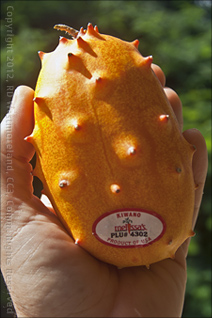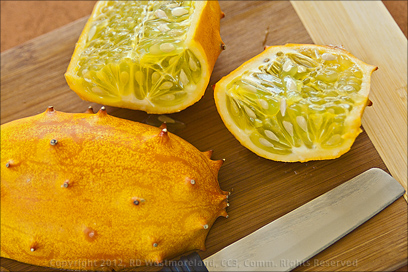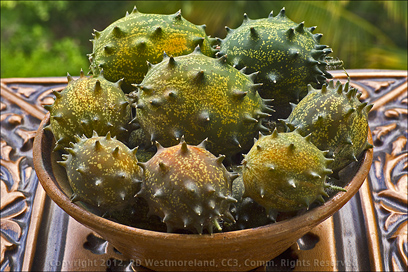Cucumis metuliferus
AKA- Kiwano, jelly melon, English tomato and cherie.
I had stumbled across the African Horned Melon while doing research about tropical fruits and veggies. My sample came from a grocery run to Walmart and cost over $6 bucks a pound. I bought one so I could retrieve the seeds.
It was bright orange and very firm.
I sliced it up it for photos and then sampled a bit. Though bizarre in appearance, it tasted like a tart, juicy cucumber and was very refreshing.  It would be perfect, put through a juicer and added to some juice or smoothie. What’s more, the entire article is edible. On a mature Kiwano, the spines are relatively soft and the skin is very thin. The spines are sharp and hard on a green ones. The seeds are edible and the ‘melons’ can be eaten green. In fact, the green ones took several weeks to turn orange so they have good ‘kitchen keeping’ properties.
It would be perfect, put through a juicer and added to some juice or smoothie. What’s more, the entire article is edible. On a mature Kiwano, the spines are relatively soft and the skin is very thin. The spines are sharp and hard on a green ones. The seeds are edible and the ‘melons’ can be eaten green. In fact, the green ones took several weeks to turn orange so they have good ‘kitchen keeping’ properties.
Restaurants use them as artistic garnish to add a touch of color.
Though they were originally from Africa, New Zealand has rebranded them as ‘Kiwanos’ and is now exporting them in quantity. My sample was actually grown in Puerto Rico.
Germinating seeds
After collecting seeds from my single specimen, I saved half and planted half.
That was way too many.
 I used one of my recycled donut trays and commercial potting soil from Home Depot. Germination was easy and I had dozens of plants in less that 2 weeks.
I used one of my recycled donut trays and commercial potting soil from Home Depot. Germination was easy and I had dozens of plants in less that 2 weeks.
After transferring about a dozen to pots, they prospered easily. So much so, that I had to put them in the ground within the next week. Of the 10 or so I planted, half failed within the first 2 weeks. I attribute that to their very delicate root structure, planting them in the shadows of other plants and their need for lots of water. The surviving 6 plants produced blossoms within 2 weeks with tiny cucumbers following a few days later.
 The root structure is very fine, very delicate which made transplanting hard.
The root structure is very fine, very delicate which made transplanting hard.
Next time, I would plant the sprouts right away and not worry with potting. On top of that, the vines are very thin and delicate.
On the plus side, they are very prolific if they get plenty of light and water. Several of the vines extended over 10 feet. Each produced about 3 to 4 cucumbers. I planted them along a chain-link fence.
 Like other melons, these are vining plants and need room to spread out.
Like other melons, these are vining plants and need room to spread out.
Now, several months later, I still have one plant producing several new cucumbers. I do water it daily.
Based on my experience, I think they could be grown in large pots if you create a place for them to trail naturally and give them lots of light and water. They will bear fruit with pollination.
I never used any fertilizer and that would have probably helped with the yield.
I’m happy with the results and plan to grow more. One of my more successful experiments.
If you are interested in reading more, here’s a link to Wikipedia’s story. As always, there are two larger images that may be seen over on Roberto’s Puerto Rico Facebook page.
Wil says
Ok I have to ask, since you didn’t mention it ;-) the tarantula….How often do you see them in your garden? Great blog entry. (S. Dog- They are nocturnal and almost impossible to spot during the day. This one basically died right there, from the night before.)
darryl says
You might need to mail me some seeds next summer.. D (S. Dog- we shall see.)